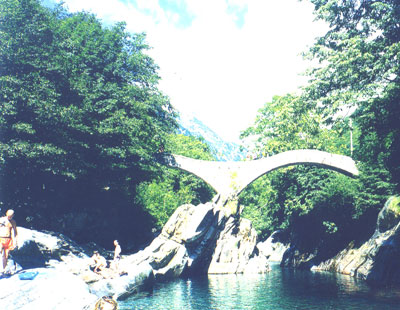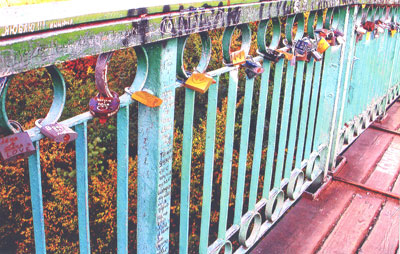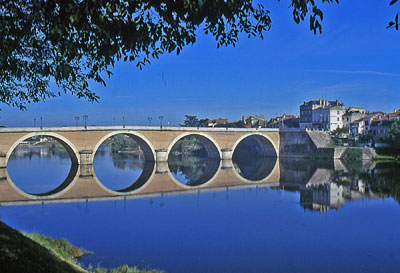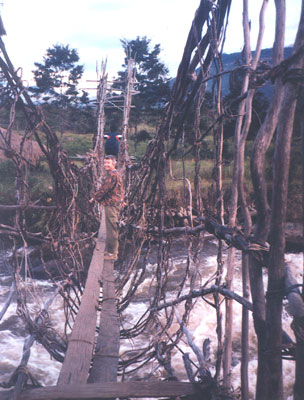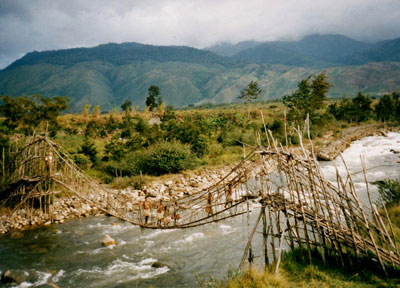Cross that bridge
We gave you this assignment: name a bridge (outside of the USA) that, for whatever reasons, is exciting to cross. Tell where it is (and, if necessary, how to find it) and approximately when you were there. Did you cross it on foot? By car? By train? Include your impressions. You may write about more than one bridge.
We printed a few responses (March, April, June & August ’10 issues). Here are a few more, with more to come. If you have one to add, write to Cross That Bridge, c/o ITN, 2116 28th St., Sacramento, CA 95818, or e-mail editor@intltravelnews.com (include the address at which you receive ITN). With photos, include captions.
In Lavertezzo, Ticino canton, Switzerland, the Ponte dei Salti (Bridge of the Jumps) is a double-arch stone footbridge that is supported in the middle by a large stone outcropping in the river. On a hot day, it’s a dream place to relax! My husband and I were there in 1998.
In August ’08 we visited Ukraine. At the northern end of Cherkassy, there is a lovely public park that has a very steep, Japanese-style moon bridge, the Bridge of Love.
Married couples put their names on a padlock and attach it to the bridge’s railing as they cross it. This is to symbolize that they have found their true love and that love will never go away.
Cherie Scudder
East Bethany, NY
On our way to join a two-week Danube cruise in October ’08, my husband, Bernie, and I stopped at the medieval city of Regensburg for three days. This was our first glimpse of the Danube, and there were also some well-preserved and beautiful sites to visit.
In Regensburg, the 336-meter-long Steinerne Brücke (Stone Bridge; see March ’10, pg. 42) was completed in AD 1146. Big and solid, the foundations of the bridge in the water made me think of a child wearing his father’s big shoes, and since the current was so fast, those stone foundations created quite a swirl just downriver.
This bridge was built so heavy and strong, even after almost 900 years it carries the weight of cars, bicycles, pedestrians and such without having any apparent damage.
Right next to the bridge is the famous Historische Wurstküche (Historic Sausage Kitchen), which has been in operation from the time of the bridge’s construction, grilling and serving mouthwatering sausages, sauerkraut and bread rolls. It was built to feed the bridge’s construction workers. Of course, we had to try the wurst, and they were delicious!
Right next to the kitchen is a building that was used as a salt warehouse in the old days. Now it’s a visitor information center and a watering hole.
Miyako Storch
Santa Barbara, CA
My first choice for an exciting bridge is in North Vancouver, British Columbia, Canada. It is a 446-foot-long pedestrian bridge across the Capilano River and thus is called the Capilano Suspension Bridge. I went across it at least three times, the last time in about 1980 with my children, all of whom are now in their 40s.
For me, it was scary. I am six feet, six inches tall, and the handrails for this bridge, which is situated 230 feet above the small river, were well below my bending range. Since this is not a bridge to walk across without some support, I had to bend to reach the protective rails.
We all made it without mishap.
Philip H. De Turk
Pinehurst, NC
My wife and I visited the commune of Bergerac in southwest France during an Elderhostel trip in the fall of 1997.
Walking from the town center, we came upon the most beautiful bridge I have ever seen. I was thunderstruck.
Spanning the Dordogne River, this awesome bridge is of medieval origin and was featured in a famous battle during the Hundred Years’ War.
The morning of our tour of Bergerac, the wind was dead calm. There was not a single ripple on the surface of the river. The bridge arches and their reflections made perfect circles. The color of the water exactly matched the color of the sky.
My hands trembled as I placed my camera on the tripod and tripped the shutter. My final exultation had to wait until I got home and saw my slides.
Looking at the photo today, it’s hard to tell where the bridge ends and its reflection begins.
David Lowe
Fullerton, CA
I don’t travel “big cities”; my passion is for the “primitive” and “ethnic,” usually in third-world destinations, where my accommodations often are tents and a sleeping bag.
In 1990, when I was 68 years old, I visited the Indonesian islands and northern Thailand on a 10-day independent trip (on which I made 27 flights). In the Baliem Valley of Irian Jaya, Indonesia, I crossed a bridge made of sticks and vines — both exciting and memorable.
These days, I’m running out of places to go, as I can’t take the heat of Africa or India anymore and I don’t “do” cold.
Phyllis Raulerson
Leonia, NJ
A friend and I joined eight other travelers on a journey to several islands of Indonesia in 1995. The most remote place we visited was the Baliem Valley of Irian Jaya (now West Papua), which with Papua New Guinea comprises a large island off the coast of Australia. It was not until 1938 that the inhabitants of the valley were discovered.
In the valley, my friend and I, with much trepidation, crossed a swaying bridge with only narrow, crudely shaped limbs crisscrossed under our feet. Grasping tightly the vines that held the bridge together, we made our way to the other side.
The Baliem Valley is inhabited by several tribes, including 250,000 Dani people, who live a very primitive existence. Reachable only by plane, Wamena, the only town in the valley, is situated at an altitude of approximately 5,000 feet. It was there that our small plane landed on a dirt airstrip and we were met by a crowd of curious inhabitants.
In the tribal villages, the women wore only grass or seed skirts while the men each sported only one item of clothing: a penis gourd.
We watched as a pig was killed with a bow and arrow, chopped in two with a stone ax, cut apart with a “knife” made of bamboo and finally roasted in a pit covered with heated stones.
Some villages in Irian Jaya, comprised of thatch-roofed huts, proudly displayed a mummy, usually the smoky remains of a tribal warrior from the past.
Noticing several women with numerous fingers missing, we were told that the women traditionally cut off a finger when a significant male within the family dies.
Crossing this bridge in Irian Jaya was like walking back in time, connecting us to a world we never knew existed.
Glenna Lybrand
Mount Ida, AR

